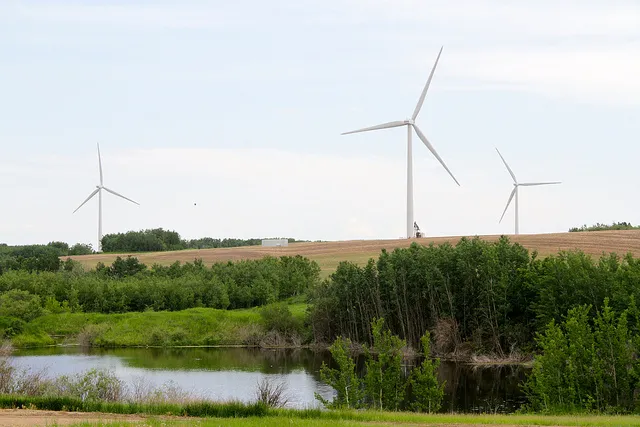What should Canada’s energy system look like in 2050? That’s the question at the heart of Generation Energy, an ongoing round of consultations being conducted by Natural Resources Canada (NRCan) under the direction of Minister Jim Carr. Pembina Institute staff recently attended a week full of workshops and presentations in Ottawa — on subjects ranging from how to improve Canada’s energy data ecosystem and its modelling of energy pathways, to the role of forest bioenergy, to the future of the power sector. Our week in Ottawa was just one part of a broader, months-long effort that will culminate on October 11 and 12 in a final meeting between the federal government and energy stakeholders in Winnipeg, Manitoba.
It’s clear that NRCan is trying to engage with the many urgent and complicated questions of Canada’s energy future, and that it’s trying to chart a path forward that acknowledges the emerging context of a carbon-constrained global economy. The pursuit is an important one: energy production and use acount for 81 per cent of Canada’s carbon pollution — so any credible long-term energy strategy must wrestle with how to ensure near-zero emissions from the energy sector in Canada by 2050. Canada’s climate and energy landscape continues to be rife with controversy over projects that don’t seem to fit with ambitious climate action, and Generation Energy could play an important role in setting a path that reconciles those contradictions.
Paris agreement upfront
We were pleased to see that the Generation Energy discussion paper framing the consultation exercise makes up-front mention of the Paris Agreement, Mission Innovation, and the Pan-Canadian Framework on Clean Growth and Climate Change (PCF). From its opening page, the paper assures readers that Canada is already “in the midst of a historic global transition to a low-carbon energy future.” There’s also a hat-tip to the 2015 Canadian Energy Strategy (CES), a document produced and agreed to by the Council of the Federation (i.e. provincial and territorial premiers). The 2015 CES acknowledged the need to see climate and energy issues through an integrated lens, but ultimately disappointed many stakeholders for its lax commitment to reducing absolute levels of carbon pollution.
The Pan-Canadian Framework on Clean Growth and Climate Change, finalized last year, is an essential package of policies to get Canada on track to achieve its 2030 climate target. But we know continued work is needed to ensure Canada meets its international commitments and decarbonizes its economy by mid-century.
Exploring the focus
The Generation Energy events we’ve attended have underscored the federal government’s longer-term focus on the need to decarbonize Canada’s economy. Throughout the week, there were all sorts of fascinating questions under discussion that explored what that focus will entail.
For example, how can energy-economy models be better calibrated to anticipate the possibility (and perhaps even the necessity) of disruptive change in the energy system? Rather than focusing purely on the need for carbon mitigation, can we do more to highlight the co-benefits of climate policy (such as improved personal mobility options) to drive transformational change in our energy systems? How can we enhance the transparency of, and access to, modelling projects typically made up of government- or private-owned software? And how can we translate the results of modelling efforts to better inform policy-making?
And what about forests? Given Canada’s great potential as a source of renewable biomass (including, among other things, wood waste, agricultural residues, pulping liquor, landfill gas, municipal and industrial wastes, firewood, and grains and oilseeds), what opportunities are there for the Canadian bioenergy and biomaterials industry? (For more on this, check out the Forest Bioeconomy Framework for Canada, a just-released strategy from the Canadian Council of Forest Ministers). What about fossil fuels in the power sector? Is there a role for natural gas to act as a “bridge” fuel in some parts of Canada’s electricity mix, and if so, how much and for how long? And how can power markets be redesigned to anticipate innovations such as distributed renewables, decentralized mini-grids, and residential- and utility-scale storage?
These and many other important questions will no doubt be up for continued discussion when NRCan’s consultations come to a close at the two-day Generation Energy Forum on October 11 and 12 in Winnipeg. On those dates, it’ll be important for energy and climate stakeholders to bring clear thinking and creativity to the task of imagining what Canada’s low-carbon future could be. The industries of the future have a smaller voice in policy discussions than most incumbent industries do—and, it’s fair to say, incumbents are likely less excited about disruptive change. But when it comes to decarbonization, disruption is just what we need. We hope that Generation Energy reaffirms the government’s commitment to advancing climate and energy issues in a mututally reinforcing way — because in this day and age, an energy strategy must be a climate strategy, and vice versa.
Once the Forum is over, NRCan has announced it will then work to issue a final report that consolidates public input and policy proposals. In the meantime, we’ll be looking forward to learning more about how Generation Energy complements the work of the PCF and refines a collective vision of Canada’s clean energy future.









